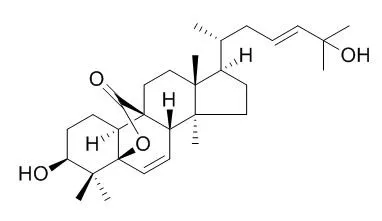| In vitro: |
| Chem Biodivers. 2012 Feb;9(2):428-40. | | Cucurbitane triterpenoids from the leaves of Momordica charantia, and their cancer chemopreventive effects and cytotoxicities.[Pubmed: 22344919] | Seventeen cucurbitane-type triterpenoids, 1-17, including six new compounds, (23E)-3β,25-dihydroxy-7β-methoxycucurbita-5,23-dien-19-al (1), (23S*)-3β-hydroxy-7β,23-dimethoxycucurbita-5,24-dien-19-al (6), (23R*)-23-O-methylmomordicine IV (7), (25ξ)-26-hydroxymomordicoside L (8), 25-oxo-27-normomordicoside L (9), and 25-O-methylKaravilagenin D (12), were isolated from a MeOH extract of the leaves of Japanese Momordica charantia.
METHODS AND RESULTS:
The structures of new compounds were elucidated on the basis of extensive spectroscopic analyses and comparison with literature. Compounds 1-17 were examined for their inhibitory effects on Epstein-Barr virus early antigen (EBV-EA) activation induced with 12-O-tetradecanoylphorbol-13-acetate (TPA) in Raji cells, a known primary screening test for inhibitors of tumor promotion. Four compounds, 1, (23E)-3β,7β-dihydroxy-25-methoxycucurbita-5,23-dien-19-al (2), Karavilagenin D (11), and 12, showed potent inhibitory effects on EBV-EA induction with IC(50) values in the range of 242-264 mol ratio/32 pmol TPA. In addition, compounds 1 and 11 exhibited inhibitory effects on skin-tumor promotion in an in vivo two-stage mouse skin carcinogenesis test based on 7,12-dimethylbenz[a]anthracene (DMBA) as initiator, and with TPA as a promoter. Furthermore, upon evaluation of the cytotoxic activities of compounds 1-17 against human cancer cell lines, compounds 2, 5-7, 9, and 14 showed potent activities against HL60 cell line, and compound 2 against SK-BR-3 cell line. |
|






 Cell. 2018 Jan 11;172(1-2):249-261.e12. doi: 10.1016/j.cell.2017.12.019.IF=36.216(2019)
Cell. 2018 Jan 11;172(1-2):249-261.e12. doi: 10.1016/j.cell.2017.12.019.IF=36.216(2019) Cell Metab. 2020 Mar 3;31(3):534-548.e5. doi: 10.1016/j.cmet.2020.01.002.IF=22.415(2019)
Cell Metab. 2020 Mar 3;31(3):534-548.e5. doi: 10.1016/j.cmet.2020.01.002.IF=22.415(2019) Mol Cell. 2017 Nov 16;68(4):673-685.e6. doi: 10.1016/j.molcel.2017.10.022.IF=14.548(2019)
Mol Cell. 2017 Nov 16;68(4):673-685.e6. doi: 10.1016/j.molcel.2017.10.022.IF=14.548(2019)